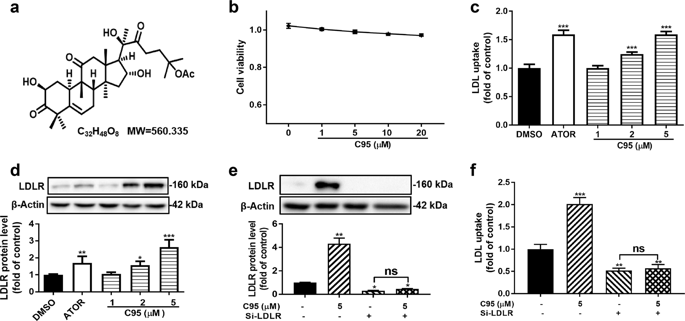当前位置:
X-MOL 学术
›
Acta Pharmacol. Sin.
›
论文详情
Our official English website, www.x-mol.net, welcomes your
feedback! (Note: you will need to create a separate account there.)
23,24-Dihydrocucurbitacin B promotes lipid clearance by dual transcriptional regulation of LDLR and PCSK9.
Acta Pharmacologica Sinica ( IF 6.9 ) Pub Date : 2019-07-29 , DOI: 10.1038/s41401-019-0274-0 Hui-Hui Li 1, 2 , Jun Li 1, 2 , Xian-Jing Zhang 1, 2 , Jiao-Meng Li 1, 2 , Cong Xi 1, 2 , Wen-Qiong Wang 1, 2 , You-Li Lu 3, 4 , Li-Jiang Xuan 1, 2
Acta Pharmacologica Sinica ( IF 6.9 ) Pub Date : 2019-07-29 , DOI: 10.1038/s41401-019-0274-0 Hui-Hui Li 1, 2 , Jun Li 1, 2 , Xian-Jing Zhang 1, 2 , Jiao-Meng Li 1, 2 , Cong Xi 1, 2 , Wen-Qiong Wang 1, 2 , You-Li Lu 3, 4 , Li-Jiang Xuan 1, 2
Affiliation

|
23,24-Dihydrocucurbitacin B (designated as C95 in this article) is a cucurbitane triterpenoid that has been shown to possess a variety of pharmacological activities, such as anti-inflammatory and anti-HIV-1 activities etc. In this study, we investigated the effects of 23,24-dihydrocucurbitacin B on lipid regulation. We showed that 23,24-dihydrocucurbitacin B (1-5 μM) dose-dependently promoted DiI-LDL uptake in HepG2 cells by upregulating low-density lipoprotein receptor (LDLR) protein. In HepG2 cells, 23,24-dihydrocucurbitacin B (1-10 μM) dose-dependently enhanced LDLR promoter activity by elevating the mature form of SREBP2 (sterol regulatory element binding protein 2) protein levels on one hand, and inhibited PCSK9 (proprotein convertase subtilisin/kexin type 9) promoter activity by attenuating HNF1α (hepatocyte nuclear factor-1α) protein levels in nuclei on the other hand. Consequently, the expression of LDLR protein markedly increased, whereas the PCSK9-mediated LDLR protein degradation decreased. In a high-cholesterol LVG golden Syrian Hamster model, administration of 23,24-dihydrocucurbitacin B (30 mg · kg-1⋅ d-1, intragastric, for 3 weeks) significantly decreased the serum LDL-cholesterol (LDL-C) levels. PCSK9 protein levels in the serum and liver tissues were significantly decreased, whereas LDLR protein levels in liver tissues were significantly increased in the treated animals as compared with the control animals. In conclusion, our study demonstrates for the first time that 23,24-dihydrocucurbitacin B exhibits dual transcriptional regulation of LDLR and PCSK9 in HepG2 cells by increasing SREBP2 protein levels and decreasing HNF1α protein levels in the nuclei. These results propose a new strategy to simultaneously manage LDLR and PCSK9 protein expression and provide a promising lead compound for drug development.
中文翻译:

23,24-Dihydrocucurbitacin B通过LDLR和PCSK9的双重转录调节来促进脂质清除。
23,24-Dihydrocucurbitacin B(在本文中称为C95)是一种葫芦素三萜类化合物,已被证明具有多种药理活性,例如抗炎和抗HIV-1活性等。在本研究中,我们进行了研究23,24-二氢葫芦素B对脂质调节的影响。我们显示23,24-dihydrocucurbitacin B(1-5μM)通过上调低密度脂蛋白受体(LDLR)蛋白质剂量依赖性地促进HepG2细胞中DiI-LDL的摄取。在HepG2细胞中,一方面通过升高成熟形式的SREBP2(固醇调节元件结合蛋白2)蛋白水平,23,24-二氢葫芦素B(1-10μM)剂量依赖性地增强了LDLR启动子活性,另一方面,通过减弱细胞核中的HNF1α(肝细胞核因子-1α)蛋白水平来抑制PCSK9(原蛋白转化酶枯草杆菌蛋白酶/ kexin型9)启动子活性。因此,LDLR蛋白的表达明显增加,而PCSK9介导的LDLR蛋白降解减少。在高胆固醇LVG黄金叙利亚仓鼠模型中,给予23,24-二氢葫芦素B(30 mg·kg-1·d-1,胃内,持续3周)可显着降低血清LDL-胆固醇(LDL-C)水平。与对照动物相比,治疗动物的血清和肝组织中的PCSK9蛋白水平显着降低,而肝组织中的LDLR蛋白水平显着升高。总之,我们的研究首次证明了23 24-dihydrocucurbitacin B通过增加SREBP2蛋白水平和降低细胞核中HNF1α蛋白水平,在HepG2细胞中表现出LDLR和PCSK9的双重转录调控。这些结果提出了同时管理LDLR和PCSK9蛋白表达的新策略,并为药物开发提供了有希望的先导化合物。
更新日期:2019-11-18
中文翻译:

23,24-Dihydrocucurbitacin B通过LDLR和PCSK9的双重转录调节来促进脂质清除。
23,24-Dihydrocucurbitacin B(在本文中称为C95)是一种葫芦素三萜类化合物,已被证明具有多种药理活性,例如抗炎和抗HIV-1活性等。在本研究中,我们进行了研究23,24-二氢葫芦素B对脂质调节的影响。我们显示23,24-dihydrocucurbitacin B(1-5μM)通过上调低密度脂蛋白受体(LDLR)蛋白质剂量依赖性地促进HepG2细胞中DiI-LDL的摄取。在HepG2细胞中,一方面通过升高成熟形式的SREBP2(固醇调节元件结合蛋白2)蛋白水平,23,24-二氢葫芦素B(1-10μM)剂量依赖性地增强了LDLR启动子活性,另一方面,通过减弱细胞核中的HNF1α(肝细胞核因子-1α)蛋白水平来抑制PCSK9(原蛋白转化酶枯草杆菌蛋白酶/ kexin型9)启动子活性。因此,LDLR蛋白的表达明显增加,而PCSK9介导的LDLR蛋白降解减少。在高胆固醇LVG黄金叙利亚仓鼠模型中,给予23,24-二氢葫芦素B(30 mg·kg-1·d-1,胃内,持续3周)可显着降低血清LDL-胆固醇(LDL-C)水平。与对照动物相比,治疗动物的血清和肝组织中的PCSK9蛋白水平显着降低,而肝组织中的LDLR蛋白水平显着升高。总之,我们的研究首次证明了23 24-dihydrocucurbitacin B通过增加SREBP2蛋白水平和降低细胞核中HNF1α蛋白水平,在HepG2细胞中表现出LDLR和PCSK9的双重转录调控。这些结果提出了同时管理LDLR和PCSK9蛋白表达的新策略,并为药物开发提供了有希望的先导化合物。






























 京公网安备 11010802027423号
京公网安备 11010802027423号